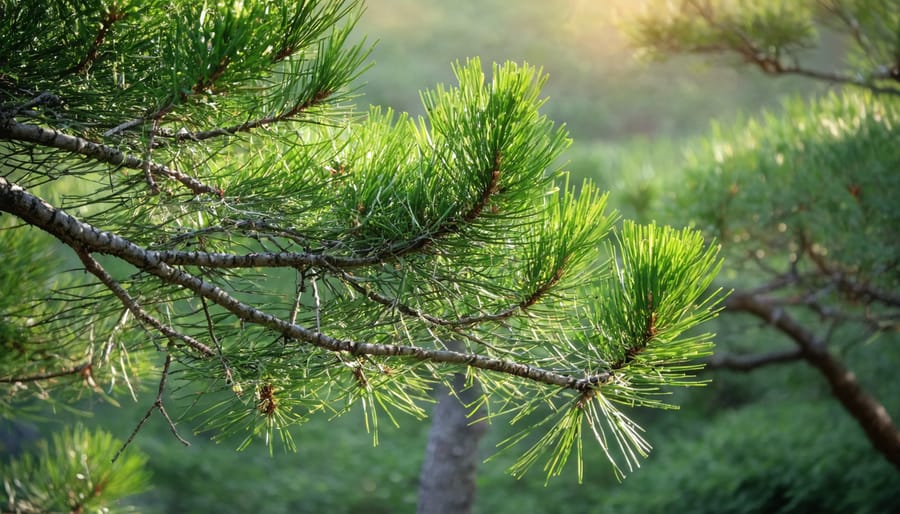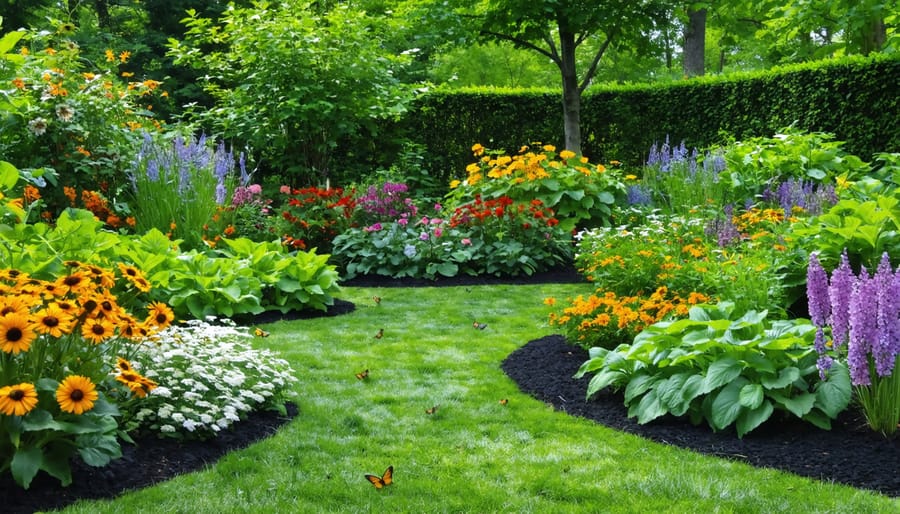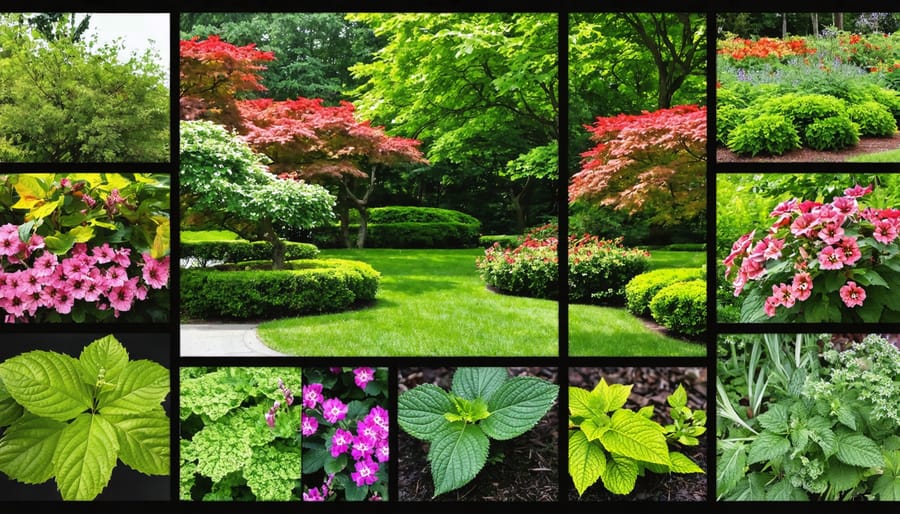Master Japanese pruning by starting with the foundational niwaki technique – shaping trees through careful ornamental tree pruning to create living sculptures that embody natural grace and artistic vision. Study the art of cloud pruning (kusamono), where branches are strategically thinned and shaped into distinctive layers that mimic windswept landscapes and rolling clouds. Apply the principle of ma (negative space) by removing up to 70% of new growth annually, allowing light and air to penetrate while maintaining the tree’s essential character. Practice selective reduction cuts on maples, pines, and junipers during early spring or late fall when sap flow is minimal, creating the distinctive asymmetrical forms that define Japanese garden aesthetics.
These centuries-old techniques transform ordinary shrubs and trees into extraordinary garden focal points, blending horticultural science with artistic expression. While mastering these methods requires patience and practice, the fundamental principles of Japanese pruning remain surprisingly accessible to gardeners at any skill level. By understanding and implementing these core concepts, you’ll develop the confidence to create your own living sculptures while honoring the time-tested traditions of Japanese garden design.
The Art of Niwaki: Japanese Tree Shaping
Cloud Pruning (Karikomi)
Cloud pruning, or Karikomi, transforms ordinary shrubs into mesmerizing cloud-like formations that seem to float in your garden. This beloved Japanese technique combines artistry with precise shaping techniques to create living sculptures that capture the essence of nature’s most elegant forms.
To begin cloud pruning, select a healthy shrub with dense foliage and strong branches. Boxwood, holly, and privet are excellent choices for beginners. Start by identifying the natural layers in your shrub and visualizing the cloud-like pads you want to create. Think of actual clouds – they’re not perfectly round but have gentle undulations and varying depths.
Using sharp pruning shears, carefully remove branches between the areas you want to develop into clouds, creating distinct spaces between each layer. Work slowly and step back frequently to assess your progress. Remember, you’re not aiming for perfectly symmetrical shapes – natural-looking clouds have organic, flowing forms.
Maintain your cloud-pruned shrubs by trimming new growth every few months during the growing season. Regular maintenance helps define the cloud shapes while encouraging dense foliage growth. Don’t worry if your first attempts aren’t perfect – like any art form, cloud pruning improves with practice and patience.
For best results, prune during early spring or late winter when plants are dormant. This timing allows your shrubs to recover and put out new growth that will fill in any gaps, creating those signature fluffy cloud formations.
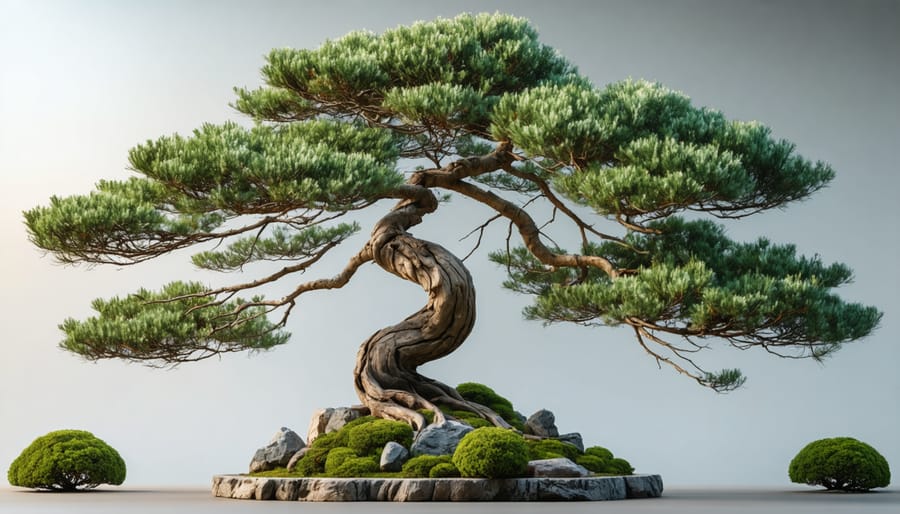
Layer Pruning (Dan-Tsukuri)
Layer pruning, or Dan-Tsukuri, is one of the most striking techniques in Japanese garden design, creating beautiful horizontal layers that mimic the natural growth patterns of trees in the wild. This method is particularly effective with conifers and evergreens, helping to showcase their natural architecture while maintaining a controlled, artistic form.
To create these distinct layers, start by identifying the strongest horizontal branches that form natural tiers. These will become your main layers, typically spaced 12-18 inches apart vertically. Begin pruning from the bottom layer and work your way up, removing any branches that interfere with the clear separation between layers.
The key to successful Dan-Tsukuri is maintaining proper spacing between layers while ensuring each tier remains full and healthy. Thin out crossing branches within each layer, focusing on keeping outward-facing growth that supports the horizontal line. Pay special attention to the tips of branches, as these will define the overall silhouette.
Japanese pines, junipers, and yews respond particularly well to this technique. When pruning, make clean cuts just above a healthy bud or branch junction to encourage new growth in the desired direction. Remember that layer pruning is an ongoing process – regular maintenance throughout the growing season helps maintain the desired shape while promoting plant health.
For best results, step back frequently to assess your work and ensure the layers remain balanced and proportional to the overall size of the tree.
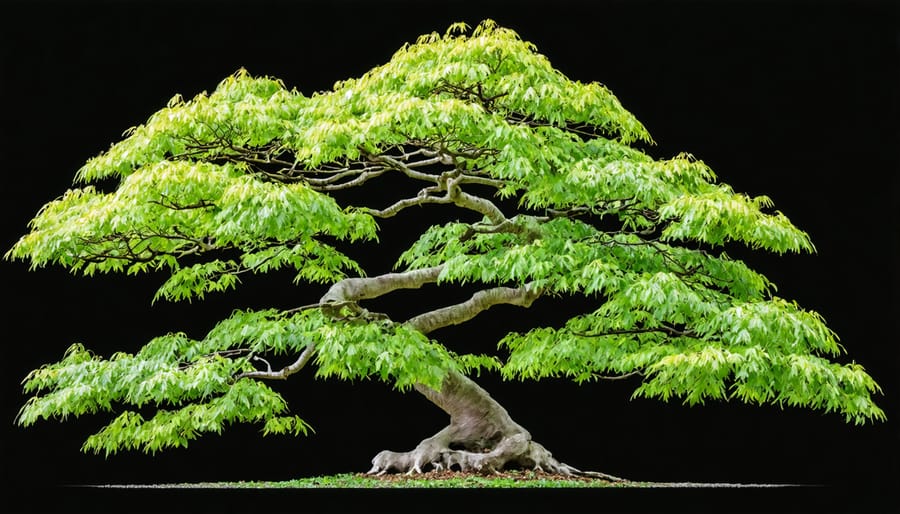

Essential Japanese Pruning Tools
Choosing and Maintaining Your Tools
Quality Japanese pruning tools are essential for achieving the precision and care that define Japanese gardening techniques. The most important tools in your kit should include a pair of hand pruners (hasami), a pruning saw (nokogiri), and butterfly shears (butterfly hasami). When selecting these tools, look for high-carbon steel blades, which stay sharp longer and provide cleaner cuts that promote better plant healing.
To maintain your tools, clean them after each use by wiping the blades with a cloth dampened with rubbing alcohol. This prevents the spread of disease between plants and removes sticky sap. Apply camellia oil to the blades regularly to prevent rust and keep the mechanisms smooth. Store your tools in a dry place, preferably hanging or in a tool roll to protect the blades.
Consider investing in a sharpening stone (toishi) to keep your tools in prime condition. Sharp tools make cleaner cuts, reducing stress on both the plants and your hands. While quality Japanese tools may seem expensive initially, with proper care, they can last for generations, making them a worthwhile investment for any serious gardener.
Seasonal Pruning Techniques
Spring and Summer Care
Spring and summer are crucial seasons for Japanese pruning, as this is when most plants experience their vigorous growth. During spring, focus on removing any dead or damaged branches that winter may have left behind. As new growth emerges, practice selective thinning by removing crossing branches and those growing toward the center of the plant to maintain good airflow.
In early summer, pinch back new shoots on evergreens to encourage dense growth and maintain the desired shape. This technique, known as metsumi, involves using your fingers to carefully remove the soft, new growth tips. For deciduous trees, wait until after the first flush of growth has hardened off before making any significant cuts.
Late summer is ideal for maintenance pruning of most Japanese garden plants. Remove any shoots that disrupt the plant’s intended form, but avoid heavy pruning during periods of intense heat. Remember to work gradually and step back frequently to assess your progress – a fundamental principle in Japanese pruning is to make thoughtful, minimal cuts rather than aggressive trimming.
Water your plants well before and after pruning to help them recover, and always use clean, sharp tools to ensure clean cuts that heal properly.
Plants Best Suited for Japanese Pruning
Japanese pruning techniques work particularly well with specific plants that can withstand regular shaping and maintain their aesthetic appeal throughout the seasons. Small ornamental trees like Japanese maples (Acer palmatum) are perfect candidates, offering delicate foliage that responds beautifully to careful pruning. Their naturally graceful form makes them ideal for creating the characteristic layered look of Japanese gardens.
Pine trees, especially Japanese Black Pine (Pinus thunbergii) and Japanese White Pine (Pinus parviflora), are traditional favorites that excel under Japanese pruning methods. These evergreens can be shaped to showcase their distinctive branches and needle clusters, creating stunning winter silhouettes.
Among the most rewarding ornamental plants for Japanese pruning are azaleas and rhododendrons. Their dense growth habit and ability to produce new shoots from old wood make them perfect for creating cloud-like forms or precise shapes. Boxwood (Buxus) varieties also respond exceptionally well to detailed pruning, making them excellent choices for creating clean lines and geometric forms.
For those just starting with Japanese pruning techniques, consider working with:
– Cotoneaster: Its flexible branches are forgiving for beginners
– Japanese Holly (Ilex crenata): Maintains shape well and recovers nicely from pruning
– Yew (Taxus): Extremely tolerant of heavy pruning and ideal for creating traditional forms
– Japanese Privet (Ligustrum japonicum): Quick-growing and resilient
These plants not only tolerate regular pruning but actually thrive when properly maintained using Japanese techniques. The key is to start with healthy specimens and maintain consistent care throughout the growing season. Remember that different plants have varying growth rates and pruning needs, so it’s best to begin with one or two species and gradually expand your collection as your skills develop.
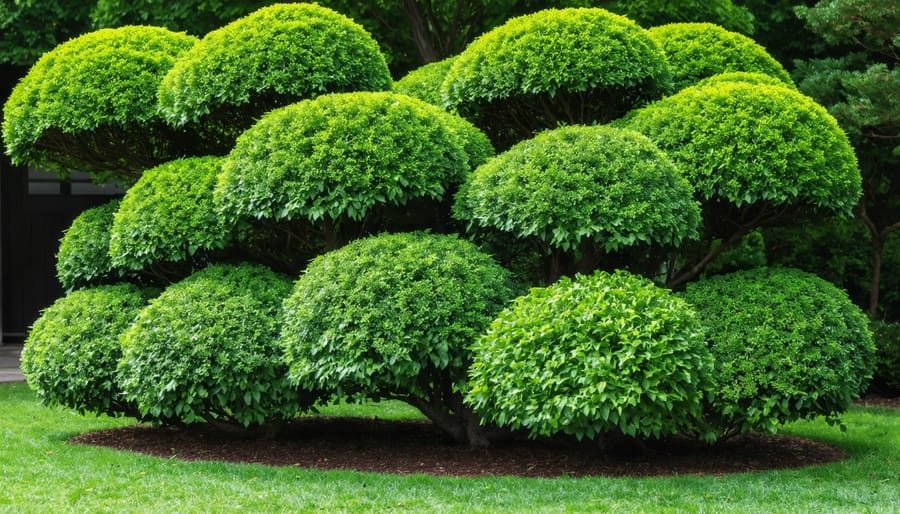
Japanese pruning techniques offer a beautiful blend of artistry and practicality that can transform any garden into a peaceful sanctuary. As we’ve explored throughout this article, these methods are more than just cutting branches – they’re about understanding and working with nature to create harmony and balance in your outdoor space.
Remember that mastering these techniques takes time and patience. Start small with a single shrub or tree, and gradually build your confidence as you become more comfortable with the basic principles. The most important elements to keep in mind are maintaining your plant’s natural shape, creating space for light and air to flow, and regularly removing dead or crossing branches.
Don’t be discouraged if your first attempts don’t look exactly like the pristine Japanese gardens you’ve admired. Every experienced gardener started as a beginner, and each plant you prune is an opportunity to learn and improve. Keep your tools sharp, take time to observe your plants before making any cuts, and always step back periodically to assess your work from different angles.
Consider joining a local gardening group or workshop to practice these techniques with other enthusiasts. Many communities offer hands-on learning opportunities where you can refine your skills under expert guidance. The satisfaction of maintaining a well-pruned garden using these time-honored Japanese techniques is truly worth the journey.
So grab your pruning shears and step into your garden with confidence. Your plants are waiting to be shaped into living works of art, one mindful cut at a time.

